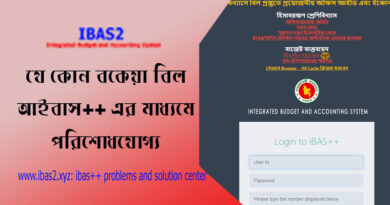BACS-Budget and Accounting Classification System
The New Budget and Accounting Classification System (BACS) has been designed to accommodate both existing needs and to meet ith demands put forth by the on going public Financial Management (PFM) reforms as well as reform agenda for the foreseeable future.
Structure of the new BACS (ibas++) The overall structure of the BACS comprises four core “posted” segments of 35 digits. These are the Organisation (11), Program (9), Fund (8) and Economic (7) segments. Posted segments are those that involve a user of the accounting system describing their transaction using these segments at the time it is entered into the system.
Structure of the new BACS
In addition, Two new posted segments with additional information are consists of the Mode of
Payment(1 digit) and the Location (8 digits). There are a further three “derived” segments: Authorization (1), Function (COFOG) (4) and Budget Sector (4). Users of BACS do not need to enter coding for these three segments as they are “derived” (produced automatically) by the system
Structure of the new BACS (ibas++)
When using the new BACS, users should be aware that it only uses “digits” (the numbers 0 to 9). It does not use alphabet letters or any other symbols.
The following summary sets out the overall structure:
Posted Core Segments (Users to enter in ibas++)
| Segment | Digits | Purpose | ||
| 1. | Organisation | 11 | Identifies the organisational unit (Ministry/Division, Department, | |
| Operating Unit) responsible for a transaction | ||||
| 2. | Operation | 9 | Identifies whether a transaction is for development or non- | |
| development purposes and, if part of an activity/ project, the | ||||
| activity/project to which it relates | ||||
| 3. | Fund | 8 | Identifies the fund in which a transaction is recorded | |
| (Consolidated Fund, Public Account) and, for those transactions | ||||
| within the Consolidated Fund, identifies whether the | ||||
| Government, a foreign grant or a foreign loan funds the | ||||
| transaction | ||||
| 4. | Economic | 7 | Identifies the economic nature of the transaction (tax or non-tax | |
| receipts, salaries, goods and services, grants, etc.) | ||||
| Posted Additional Information Segments (Users to enter limited data as required in iBAS) | ||||
| Segment | Digits | Purpose | ||
| 5. | Mode of Payment | 1 | Identifies whether a transaction is reimbursable project | |
| expenditure or direct project assistance | ||||
| 6. | Location | 8 | Identifies the location to which a transaction should be attributed | |
| Derived Segments (Pre-defined in iBAS) | ||||
| Segment | Digits | Purpose | ||
| 7. | Authorisation | 1 | Identifies whether an expenditure transaction is voted or charged | |
| expenditure | ||||
| 8. | Function (COFOG) | 4 | Identifies the purpose of a transaction according to the | |
| Classification of Functions of Government (COFOG) | ||||
| 9. | Budget Sector | 4 | Identifies the budgetary sector to which a transaction should be | |
| attributed |
The aims of the BACS is to meet four fundamental purpose; codifying planned and actual financial transactions, capturing information, transaction analysis and budgetary control. Therefore, the task of any classification system in to identify the core similarities in government operations and organize individual transaction into homogeneous categories.









